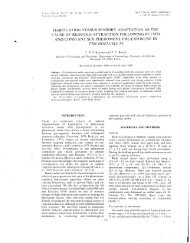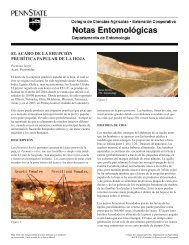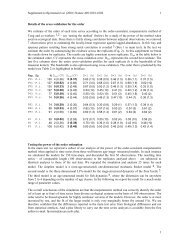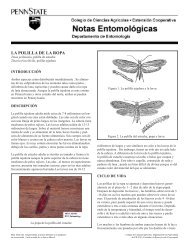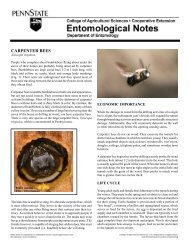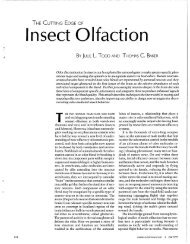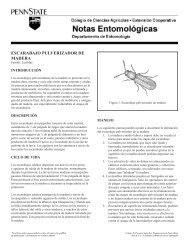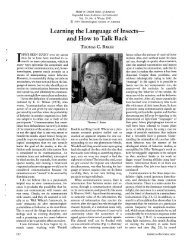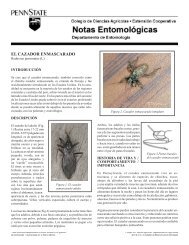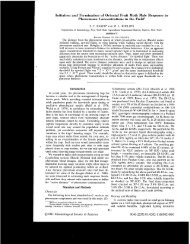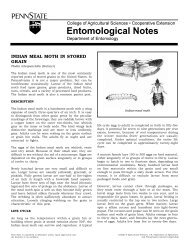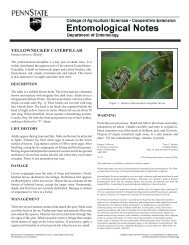House Flies and Pig Manure Volatiles: Wind Tunnel ... - Entomology
House Flies and Pig Manure Volatiles: Wind Tunnel ... - Entomology
House Flies and Pig Manure Volatiles: Wind Tunnel ... - Entomology
You also want an ePaper? Increase the reach of your titles
YUMPU automatically turns print PDFs into web optimized ePapers that Google loves.
<strong>House</strong> <strong>Flies</strong> <strong>and</strong> <strong>Pig</strong> <strong>Manure</strong> <strong>Volatiles</strong>:<br />
<strong>Wind</strong> <strong>Tunnel</strong> Behavioral Studies <strong>and</strong><br />
Electrophysiological Evaluations1<br />
Allard A Coss6 <strong>and</strong> Thomas C, Baker<br />
Department of <strong>Entomology</strong><br />
Iowa State University<br />
Ames, Iowa 50011-3222 USA<br />
J Agric Entomol 13(4): 301-317 (October 1996)<br />
ABSTRACT Nine compounds from the headspace of fresh pig manure<br />
were identified as electrophysiologically active on virgin female house fly<br />
(Musca domstica L ) antennae, <strong>and</strong> mixtures of these compounds attracted<br />
female house flies in wind-tunnel behavioral assays Identification was<br />
accomplished by using coupled gas chromatographic-electroantennographic<br />
(GC-EAG) recordings, coupled gas chromatographic-mass spectrometric (GC-<br />
MS) analysis, electroantennographic (EAG) assays of st<strong>and</strong>ards, <strong>and</strong> wind<br />
tunnel behavioral studies The pig manure volatiles eliciting responses from<br />
female antennae were butanoic acid, 3-methylbutanoic acid, dimethyldisulfide,<br />
dimethyltrisulfide, dimethyltetrasulfide, phenol, benzeneethanol, indole, <strong>and</strong><br />
3-methylindole In EAG dose-response tests butanoic acid, 3-methylbutanoic<br />
acid, indole, <strong>and</strong> 3-methylindole elicited the highest responses on female<br />
house fly antennae, <strong>and</strong> dimethyltrisulfide, phenol, <strong>and</strong> benzeneethanol<br />
elicited more moderate responses In wind-tunnel behavioral studies, female<br />
house flies flew upwind in the plume <strong>and</strong> l<strong>and</strong>ed on the source in response to<br />
pig manure volatiles The ability of individual EAG-active compounds to<br />
attract female house flies was not significantly greater than that of the<br />
control However, two mixtures, one comprised of seven EAG-active<br />
compounds <strong>and</strong> a second made up of only three compounds, were capable of<br />
attracting female flies in a similar manner as found with pig manure The<br />
behavioral significance of these compounds as potential attractants is<br />
discussed<br />
KEY WORDS Diptera, Muscidae, Musca domestica, house fly, pig manure<br />
volatiles, gas chr omatogr aphid-electr oantennogr aphic recordings, mass<br />
spectrometry, attractants, wind tunnel, behavior<br />
The house fly (Musca dornestica L.) enjoys a cosmopolitan distribution. The<br />
enormous potential that this species possesses for pathogen transmission is well<br />
documented (Greenberg 1973, West & Peters 1973) In addition to transmitting<br />
disease the house fly is a major pest in or around livestock, swine, <strong>and</strong> poultry<br />
Accepted for publication 27 June 1996
302 J Agric Entomol Vol 13, No 4 (1996)<br />
facilities (West 1951) Heavy fly populations not only can cause actual<br />
economic losses in production to various classes of livestock but also can cause<br />
economic losses due to lawsuits against livestock production units due to the<br />
flies, odor, <strong>and</strong> dust being cited as nuisances (Campbell 1993) Insecticides<br />
have been used as the primary method for fly control for the last 100 yr <strong>and</strong> are<br />
still widely employed today In spite of the large numbers of chemical products<br />
available, heavy fly populations are still present at livestock installations <strong>and</strong><br />
they do disperse into urban areas (Thomas & Skoda 1993) Many house fly<br />
control failures have been attributed to insecticide resistance (Meyer et a1<br />
1987, Scott & Georghiou 1985) One of the alternative control methods for<br />
house flies is attractants, which can be deployed in the domestic <strong>and</strong> feedlot<br />
environment However, existing commercial house fly attractant baits have<br />
shown mixed results (Browne 1990) Studies on attractants for the house fly<br />
are not new <strong>and</strong> have focused on evaluating the attractancy of single<br />
compounds or complex odorant mixtures in olfactometers, small rooms, <strong>and</strong> the<br />
field (West & Peters 1973 <strong>and</strong> references therein) These studies have<br />
demonstrated that mixtures are more attractive than single chemicals (Brown<br />
et a1 1961, Mulla et a1 1977, Kunast & Gunzrodt 1981) The most effective<br />
attractants for house flies are natural products, <strong>and</strong> especially effective are the<br />
products of putrefaction <strong>and</strong> fermentation, the sources of which can serve as<br />
oviposition sites <strong>and</strong> food sources Dairy products <strong>and</strong> sugar-containing<br />
substances also are considered attractive (Kunast & Gunzrodt 1981).<br />
<strong>Manure</strong> <strong>and</strong> spilled feed are the principal breeding media for the house fly<br />
(Skoda & Thomas 1993) Larsen et al. (1966) showed that odor taken from air<br />
that has passed through a mixture of water <strong>and</strong> pig manure was attractive to<br />
house flies in an olfactometer, <strong>and</strong> that of eight different types of manure<br />
tested, pig manure was the most favorable site for oviposition Considerable<br />
effort has been expended to identify the compounds emanating from livestock<br />
manure In pig manure, at least 140 different volatile compounds <strong>and</strong> gases<br />
have been identified (Yasuhara & Fuwa 1979, Spoelstra 1980, Yasuhara et a1<br />
1984, O'Neill & Phillips 1992, Chen et al. 1994) There is, however, a paucity of<br />
literature regarding the actual volatile compounds in pig manure that are<br />
responsible for attracting house flies<br />
In the present study we report the use of a novel approach to identify<br />
possible attractants for the house fly <strong>Pig</strong> manure volatiles were analyzed by<br />
coupled gas chromatographic-electroantennographic (GC-EAG) <strong>and</strong> coupled<br />
GC-mass spectrometry (GC-MS) assays to isolate <strong>and</strong> identify those compounds<br />
in the headspace of pig manure that are biologically active We then tested<br />
synthetic samples of these compounds, alone <strong>and</strong> as mixtures, in wind-tunnel<br />
behavioral bioassays<br />
Materials <strong>and</strong> Methods<br />
Insects. Musca domestics were obtained as pupae from a colony maintained<br />
at the Department of <strong>Entomology</strong>, Iowa State University, <strong>and</strong> kept at 25OC<br />
under a 14:lO (L:D) h photoperiod regime until they emerged Adults were<br />
chilled (ca 90 s at -20°C <strong>and</strong> the sexes separated within 12 h after they<br />
emerged Males <strong>and</strong> females were placed in separate cages <strong>and</strong> given access to
COSSE & BAKER: <strong>House</strong> <strong>Flies</strong> <strong>and</strong> <strong>Pig</strong> <strong>Manure</strong> <strong>Volatiles</strong> 303<br />
water <strong>and</strong> a mixture of dry whole milk <strong>and</strong> powdered sugar (1:l) <strong>Flies</strong> used in<br />
experiments were between 5 <strong>and</strong> 16 d old<br />
Collection of pig manure volatiles. <strong>Pig</strong> manure, comprised of pig urine<br />
<strong>and</strong> feces, was gathered immediately after excretion The manure was divided<br />
into 2 5-g samples that were placed in 2-dram (7 4-ml) vials filled with 2 5 g of<br />
HPLC-grade water <strong>and</strong> capped with Teflon-coated septa (Supelco, Inc ,<br />
Bellefonte, Pennsylvania) Fifty-gram samples also were prepared <strong>and</strong> placed<br />
in 100-ml polypropylene bottles filled with 50 g of HPLC-grade water All<br />
samples were stored at -20°<br />
Headspace collections of volatiles from the pig manure were obtained by two<br />
different methods The first method, which does not require the use of solvents,<br />
collected pig manure volatiles directly from 2-dram sample vials by solid phase<br />
microextraction (SPME) (Supelco, Inc , Bellefonte, Pennsylvania). The SPME<br />
unit consisted of a fiber coated with 100 pm of polydimethylsiloxane contained<br />
within a syringe The fiber was extruded from the syringe <strong>and</strong> inserted into the<br />
headspace of a 2-dram vial containing pig manure for 10 min at room<br />
temperature (ca 25'-2S°C) after which it was retracted <strong>and</strong> immediately<br />
inserted into the injector port of a GC (HP 5890 gas chromatograph, Hewlett-<br />
Packard Co , Palo Alto, California) where it was thermally desorbed For the<br />
second method, a 50-g pig manure sample was placed in a two-necked 250-ml<br />
flask Charcoal-filtered air was blown over magnetically stirred manure at a<br />
rate of 3 mlls for 16 h at room temperature <strong>Volatiles</strong> were collected in a glass<br />
tube (10 cm long X 4 mm ID) containing 50 mg of pre-cleaned Tenax TA<br />
(Alltech Associates, Inc , Deerfield, Illinois) placed between two glass wool<br />
plugs The Tenax TA trap was desorbed with 1 ml of redistilled HPLC-grade<br />
hexane Each sample was concentrated to ca 200 pl under nitrogen <strong>and</strong><br />
immediately analyzed by GC-EAG <strong>and</strong> GC-MS<br />
Chemical analyses. One-microliter aliquots of the Tenax TA-collected pig<br />
manure volatiles were injected in splitless mode onto 30 m X 0 25 mm ID fused<br />
silica capillary gas chromatographic columns, coated either with DB-1 or DB-<br />
225 (J& W Scientific, Folsom, California) for analysis by GC-EAG <strong>and</strong> GC-MS<br />
Column conditions were as follows: He carrier gas flow of 15 mllmin, injector<br />
temperature 250°C 1 min delay on inlet purge, 4 min at 35OC then 25OCImin to<br />
320° (DB-1) or 15OCImin to 220° (DB-225) The SPME samples were<br />
analyzed by using the above mentioned conditions with a 4-min delay on inlet<br />
purge<br />
GC-MS analyses were performed by using the HP 5890 gas GC with a direct<br />
interface to a Hewlett-Packard 5970 mass selective detector (electron impact,<br />
Electroantennogram responses. Simultaneous GC-EAG <strong>and</strong> EAG<br />
analyses were perf01 med according to st<strong>and</strong>ard methods (e g , Cosse et a1 1995,<br />
Baker et a1 1991) by using a HP 5890 GC EAG recordings were made by<br />
inserting a glass pipette AgIAgCl saline electrode (World Precision<br />
Instruments, Sarasota, Florida) in the back of an excised house fly head A<br />
second saline recording electrode was placed in contact with the distal end of<br />
the funiculus of one of the antenna Both pipettes were filled with Beadle-<br />
Ephrussi (Ephrussi & Beadle 1936) saline To examine antenna1 sensitivity to<br />
the identified pig manure volatiles, EAGs that were not coupled to the GC were
304 J Agric Entomol Vol 13, No 4 (1996)<br />
recorded in response to a dose-response series of commercial compounds. Serial<br />
dilutions of the tested compounds were made in redistilled HPLC-grade<br />
methylene chloride such that the tested compounds were applied to filterpaper-strips<br />
(0 5 cm X 3 0 cm, Whatman No 1) in 10 pl of solvent The filterpaper-strips<br />
were placed inside glass Pasteur pipettes (15 cm long) The<br />
antenna was continuously flushed with a charcoal-filtered <strong>and</strong> moistened<br />
airstream The air, flowing at a rate of 20 mlls, was delivered through a glass<br />
tube (8 mm ID) ending 10 mm in front of the preparation Two milliliters of the<br />
atmosphere of the stimulus pipette was puffed into the constant airstream by a<br />
mechanical puffing device (Syntech, Hilversum, The Netherl<strong>and</strong>s), delivering<br />
0 1-s puffs The stimulus was injected into the airstream 15 cm upstream from<br />
the antenna Control puffs (filter paper plus solvent) were presented to each<br />
EAG preparation before <strong>and</strong> after the test compounds To compensate for<br />
possible deterioration of the preparation <strong>and</strong> differences in quality of the<br />
electrical connection, EAG amplitudes were normalized by dividing the<br />
amplitude of the EAG generated from a test compound by the mean of the<br />
control response Each value thus yielded an estimate of relative EAG<br />
amplitude Within a particular series of test compounds, presentation of the<br />
test compounds was r<strong>and</strong>omized EAG data were subjected to ANOVA <strong>and</strong><br />
mean responses were compared by using the LSD method (Sokal & Rohlf 1981)<br />
Chemicals. Butanoic acid, 3-methylbutanoic acid, 3-methylindole, indole,<br />
3-methylphenol, 4-methylphenol, <strong>and</strong> benzeneethanol were obtained from<br />
Sigma Chemical Co (St Louis, Missouri) <strong>and</strong> were >99% pure (label<br />
information <strong>and</strong> GC analyses) Phenol, 8-3-carene, (±)-a-pinene(IS)-(-)+-<br />
pinene, <strong>and</strong> 4-ethylphenol were purchased from Aldrich Chemical Co<br />
(Milwaukee, Wisconsin) <strong>and</strong> were >95% pure Dimethyltrisulfide was obtained<br />
from Narchem Corp (Chicago, Illinois) <strong>and</strong> was >99% pure The<br />
dimethyltetrasulfide, purchased from Oxford Organics, Inc (Elizabeth, New<br />
Jersey) was a mixture of dimethyltetrasulfide (33%) <strong>and</strong> dimethyltrisulfide<br />
(50%) based on GC-MS comparisons with the commercial sample of<br />
dimethyltrisulfide<br />
<strong>Wind</strong> tunnel. Behavioral assays were conducted in a modified 2 4 m X 10 m<br />
X 10 m wind tunnel described previously by Miller & Roelofs (1978) The wind<br />
speed was adjustable (0 to 100 cds) <strong>and</strong> was set at 50 cds. The temperature in<br />
the wind tunnel was 23 Â 2OC White paper covered the outside of the tunnel to<br />
eliminate potential distractions to flies <strong>and</strong> diffused the light coming from four<br />
pairs of white fluorescent lamps running the length of the tunnel top <strong>and</strong><br />
positioned 1 m above the ceiling of the tunnel A visual pattern consisting of 6-<br />
cm-diam red vinyl dots was placed underneath the transparent tunnel floor<br />
Small flaps covering peep holes in the white-paper paneling were opened from<br />
time to time to allow for observations of the flies during experiments The flight<br />
tracks of the flies, together with the audio observations of the experimenter,<br />
were recorded onto cassette tape by using a Toshiba KV 6300A recorder <strong>and</strong> a<br />
Sony M374 black-<strong>and</strong>-white video camera located ca 50 cm above the ceiling of<br />
the tunnel The field of view for all recordings was 12 m long extending from 55<br />
cm to 175 cm downwind from the upwind end of the tunnel <strong>and</strong> extending the<br />
width of the tunnel Recordings of fly behaviors were played back in slow motion<br />
through a 47 5-cm black-<strong>and</strong>-white Panasonic WV 5470 television monitor
COSSE & BAKER: <strong>House</strong> <strong>Flies</strong> <strong>and</strong> <strong>Pig</strong> <strong>Manure</strong> <strong>Volatiles</strong> 305<br />
<strong>Wind</strong>-tunnel behavioral bioassays. Virgin females were placed in groups<br />
of five or six in screened release cages (6 cm X 10 cm ID), covered with Petri<br />
dish lids, 3 h before being tested, <strong>and</strong> then were released between 5-8 h into<br />
the photophase The release cage was placed on a platform (15 cm X 15 cm) 60<br />
cm away from the downwind screen <strong>and</strong> 25 cm above the tunnel floor The<br />
Petri dish lid was attached to a wire that was pulled up from the tunnel top ca<br />
15 s after the introduction of the odor source The clear Petri dish lid together<br />
with its friction-free rapid removal prevented the evocation of an escape<br />
response in the flies (Holmqvist & Srinivasan 1991) The odor source,<br />
formulated in 10 ml of water, was introduced in a Petri dish (15 cm X 10 cm<br />
ID) placed on a platform 60 cm away from the upwind screen <strong>and</strong> 25 cm above<br />
the tunnel floor The odor source was presented as a turbulent plume (as<br />
visualized by TiC14 smoke prior to the bioassays) that moved over <strong>and</strong> through<br />
the release cage The distance between the release cage <strong>and</strong> odor source was 1<br />
m In addition to video recording, the behavior of flies was recorded by the<br />
experimenter from the side, who observed whether or not the flies were flying<br />
at the height of the odor plume <strong>and</strong> also gave additional information about the<br />
3-dimensional aspects of the flight tracks Tracks were recorded for 4 min after<br />
the removal of the Petri dish cover Upon analysis during replay those tracks<br />
in which flies exhibited plume-oriented upwind flight behavior were scored for<br />
the upwind flight distance attained by the flies (either 60 cm or 95-100 cm from<br />
the release point) <strong>and</strong> also for whether or not the flies l<strong>and</strong>ed on the source<br />
The upwind progress score was calculated per fly unit, with a fly unit expressed<br />
as the total number of plume-oriented upwind flights per group divided by the<br />
number of individual flies per group Odor sources were chosen at r<strong>and</strong>om,<br />
each source was tested on one single day, <strong>and</strong> the experiments were performed<br />
for 12 consecutive days The data were subjected to ANOVA <strong>and</strong> means were<br />
compared by using the T-method (Sokal & Rolhf 1981)<br />
Flight track analyses. Individually released females had their upwind<br />
flight tracks video-recorded from ca 50 cm above the tunnel ceiling by using<br />
two Sony M374 black-<strong>and</strong>-white video cameras connected to two Toshiba KV<br />
6300A video recorders Measuring the total field of view of the partial<br />
overlapping camera views at the level of a TiC14 smoke plume (25 cm above the<br />
wind tunnel floor) yielded a 1.0 m (14 m rectangular area, which extended from<br />
40 cm to 180 cm downwind from the upwind end of the tunnel Only flight<br />
tracks of females that flew upwind in the plume <strong>and</strong> contacted the pig manure<br />
(2 5 g in 10 ml of H20) odor source were analyzed The recordings of the female<br />
flight tracks were played back frame-by-frame through a 47 5-cm black-<strong>and</strong>white<br />
Panasonic WV 5470 television monitor Every other frame (each 1130th s)<br />
together with three points of reference on the wind tunnel floor <strong>and</strong> the fly's<br />
location were captured by using a computer video frame-grabber board<br />
(Odavision4, Hammerkop Co , Massachusetts) The X <strong>and</strong> Y coordinates of the<br />
fly location in a two-dimensional plane were obtained by using digitizing<br />
Mantid computer software (Hammerkop Co , Massachusetts) <strong>and</strong> were<br />
analyzed for net upwind flight speed The release of the individual females was<br />
similar to that described for the wind-tunnel bioassays with the exception that<br />
the release cage <strong>and</strong> odor source were placed 50 cm away from the tunnel ends,<br />
creating a distance of 12 m between release cage <strong>and</strong> odor source
306 J Agric Entomol Vol 13, No 4 (1996)<br />
Results<br />
Analyses of pig manure volatiles. Twenty-two GC-EAG analyses of the<br />
volatiles collected from pig manure were obtained by using 22 different female<br />
house fly antennae Only those GC peaks that consistently revealed<br />
simultaneous EAG activity were targeted for further analysis GC-EAG analyses<br />
consistently revealed eight GC peaks on both DB-1 <strong>and</strong> DB-225 columns with<br />
corresponding EAG activity on female house fly antennae (Fig 1 <strong>and</strong> Table 1,<br />
peak no 3,4, 7, 9, 15, 17, 18, <strong>and</strong> 19) The retention times on both columns <strong>and</strong><br />
GC-MS spectra of peak no 3,4, 7, 9, 15, 17, 18, <strong>and</strong> 19 corresponded precisely to<br />
those of eight compounds known to be present in the headspace of pig manure:<br />
butanoic acid, 3-methylbutanoic acid, dimethyltrisulfide, phenol, benzeneethanol,<br />
dimethyltetrasulfide, indole, <strong>and</strong> 3-methylindole, respectively Moreover,<br />
combined GC-EAG recordings on both DB-1 <strong>and</strong> DB-225 columns demonstrated<br />
that butanoic acid, 3-methylbutanoic acid, dimethyltrisulfide, phenol,<br />
benzeneethanol, dimethyltetrasulfide, indole, <strong>and</strong> 3-methylindole had retention<br />
times identical to peak no 3, 4, 7, 9, 15, 17, 18, <strong>and</strong> 19, respectively, from the<br />
collected pig manure volatiles, <strong>and</strong> that these compounds were EAG-active (Table 1)<br />
Seven of our 22 GC-EAG analyses showed an additional (ninth) EAG-active peak,<br />
<strong>and</strong> a subsequent GC-MS library search tentatively identified this peak as<br />
dimethyldisulfide (Table 1) Comparison between SPME-collected volatiles vs<br />
Tenax TA-collected materials revealed no prominent differences in the number of<br />
compounds detected However, there were differences in the ratios of the<br />
compounds collected via each method, <strong>and</strong> compounds eluting from the capillary<br />
columns during the first 3 rnin of the runs where hidden by the solvent peak in<br />
the Tenax collection method In both methods, 4-methylphenol was always the<br />
major compound collected<br />
Electroantennogram responses The EAG responses of female house fly<br />
antennae to puffs of seven of the GC-EAG-active compounds were recorded at<br />
five dosages (Fig 2) EAG amplitudes increased to puffs from cartridges<br />
containing from 0 1 pg up to 100 pg for all of the compounds tested All<br />
responses were significantly higher than those from the control (solvent)<br />
cartridges Even at the lowest dosage tested, the responses to all of the<br />
compounds were at least 15-times greater than to those of the control<br />
Analysis of variance of the antenna1 responses indicated that there were<br />
significant differences not only between the responses of the flies to the various<br />
doses tested (F= 227 34, df= 4, 315; P Ã 0 001) <strong>and</strong> between the different<br />
chemicals (F= 73 76, df= 6, 315; P Ã 0 001) but also that the interaction<br />
between doses <strong>and</strong> chemicals was significant (F= 21 96, df= 24,315; P Ã 0 001)<br />
Furthermore, the data show that, of the compounds tested, butanoic acid<br />
elicited the highest EAG responses at all dosages except 0 1 pg Conversely,<br />
benzeneethanol elicited the lowest responses at all dosages except 0 1 pg (Fig<br />
2) The EAG responses elicited by 3-methylindole <strong>and</strong> indole were not<br />
significantly different from each other at all dosages tested The dose-response<br />
curves also indicate that maximum responses had been reached at the 100-pg<br />
dosage with butanoic acid, 3-methylbutanoic acid, 3-methylindole, <strong>and</strong><br />
dimethyltrisulfide, whereas responses to the 1,000-pg dosage of indole, phenol,<br />
<strong>and</strong> benzeneethanol had still not peaked (Fig 2)
COSSE & BAKER: <strong>House</strong> <strong>Flies</strong> <strong>and</strong> <strong>Pig</strong> <strong>Manure</strong> <strong>Volatiles</strong> 307<br />
15<br />
Time (rnm)<br />
Fig. 1 Simultaneously recorded gas chromatogram of pig manure volatiles<br />
collected by solid phase microextraction (A) <strong>and</strong> electroantennogram of<br />
a female house fly antenna (B) Electrophysiologically active<br />
compounds are labeled with an asterisk Number labels indicate<br />
identified materials (see Table 1)<br />
<strong>Wind</strong>-tunnel behavioral assays Virgin female house flies readily flew<br />
upwind to volatiles emitted from pig manure: 44 l<strong>and</strong>ings on the source were<br />
recorded using four groups of flies (totaling 22 flies released) (Fig 3) Female<br />
flies also flew upwind <strong>and</strong> l<strong>and</strong>ed on the source in response to volatiles emitted<br />
from mixtures of chemicals identified from the headspace of pig manure In<br />
instances where extended observations of individual flies were possible, flies<br />
made several upwind-oriented flights in the plume of varying distances <strong>and</strong><br />
made several successful l<strong>and</strong>ings on the source during the 4-min response time<br />
Typically, after removal of the Petri dish cover, the quiescent female would<br />
remain inactive for several seconds before flying upwind in a zigzag pattern
308 J Agric Entomol Vol 13, No 4 (1996)<br />
Table 1. Analytical results of pig manure volatiles.<br />
Peak no," Compound GC-EAG active6 Identificationc<br />
dimethyldisulfide<br />
acetic acid<br />
butanoic acid<br />
3-methylbutanoic acid<br />
pentanoic acid<br />
hexanoic acid<br />
dimethyltrisulfide<br />
a-pinene<br />
phenol<br />
p-pinene<br />
8-3-carene<br />
limonene<br />
4-methylphenol<br />
3-methylphenol<br />
benzeneethanol<br />
4-ethylphenol<br />
dimethyltetrasulfide<br />
indole<br />
3-methylindole<br />
hexadecanoic acid<br />
octadecanoic acid<br />
"Numbers cor~espond to labeled peaks in Fig 1<br />
b~as chromatographic-coupled-electroantennogram (GC-EAG)(see also Fig 1); + , active; -, not active<br />
"Identification is based on a mass spectrum library search (MS) <strong>and</strong>lor comparison of mass spectra of<br />
the natural material with that of the identified synthetic compound (GC& MS)<br />
toward the pig manure odor source Females that upon release flew upwind in<br />
the plume <strong>and</strong> l<strong>and</strong>ed directly on the source exhibited a mean net upwind flight<br />
speed of 40 4 cm/s (±I 4 SD, n= 4) (Fig 4) Of the females released in groups<br />
of five or six, only a few flew directly to the manure, the majority flying toward<br />
the source in the plume <strong>and</strong> aborting their upwind progress at various<br />
distances downwind of the source Those females that l<strong>and</strong>ed on the source<br />
were observed to feed Analysis of variance of the behavioral responses showed<br />
that there were significantly more upwind flights <strong>and</strong> l<strong>and</strong>ings on the source<br />
with pig manure than with the water control (Table 2) The attractancy of<br />
individual EAG-active compounds was not significantly different than that of<br />
the control However, two mixtures, one comprised of seven EAG-active<br />
compounds <strong>and</strong> a second made up of equal amounts of butanoic acid, 3-<br />
methylindole, <strong>and</strong> dimethyltrisulfide, elicited upwind flights at a rate not<br />
significantly different than that to pig manure However, the rate of l<strong>and</strong>ing on<br />
the source was lower than that evoked by pig manure The frequencies of
COSSE & BAKER: <strong>House</strong> <strong>Flies</strong> <strong>and</strong> <strong>Pig</strong> <strong>Manure</strong> <strong>Volatiles</strong><br />
butanoic acid<br />
phenol<br />
dosW4lV~l<br />
3.methylbutanoic acid<br />
dosage IVg)<br />
benzeneethanol<br />
Fig. 2. Electroantennogram (EA,G) dose responses of female house fly antennae<br />
to selected known volatile compounds released by pig manure, Stimuli<br />
were synthetic st<strong>and</strong>ards" EAG amplitudes were normalized by dividing<br />
the amplitude of the EAG generated from the test compounds by the<br />
mean of the control responses, St<strong>and</strong>ard deviations of mean responses<br />
are presented as error bars,, EAG responses for each dosage were<br />
compared by ANOVA,, Dosage means between the different stimuli with<br />
the same letter are not significantly different by the LSD method (Sokal<br />
& Rohlf 1981) at P < 0,,05,,
310 J Agric Entomol Vol 13, No 4 (1996)<br />
Source<br />
2<br />
Fig. 3,, <strong>Wind</strong>-tunnel behavioral responses of female house flies to pig manure,<br />
synthetic pig manure volatiles, <strong>and</strong> mixtures of synthetic pig manure<br />
volatiles,, Odor sources were formulated in 10 ml of water at dosages of<br />
20 pg except for pig manure (2.5 g), (a) ratio of 1,s : 1, 20 pg total<br />
amount <strong>and</strong> (b) ratios of 1 : 1, 20 pg of each compound. Females were<br />
released in four groups, each containing five or six flies, totalling 22<br />
flies for each treatment,
COSSE & B mR: <strong>House</strong> <strong>Flies</strong> <strong>and</strong> <strong>Pig</strong> <strong>Manure</strong> <strong>Volatiles</strong><br />
downwind Track no,, 1 upwmd<br />
wind direction t<br />
I<br />
0 10 20 30 40 50 60 70 80 90 I00 I10 120 130 140 150 160 170 180 190 200 210 220 230 240<br />
Distance (cm)<br />
downwind Track no 2 upwind<br />
wind direction t<br />
Distance (cm)<br />
50<br />
downwlnd Track no, 3 upwind<br />
I<br />
wind direction 4---<br />
Distance (cm)<br />
Fig. 4 Three flight tracks of flying M domestzca females in response to pig<br />
manure odor (2.5 g in 10 ml of H20) Large rectangular boxes represent<br />
the wind-tunnel floor area <strong>Wind</strong> speed was set at 50 cds. Dots are<br />
1130th s apart
COSS'E & B m R <strong>House</strong> <strong>Flies</strong> <strong>and</strong> <strong>Pig</strong> <strong>Manure</strong> <strong>Volatiles</strong> 313<br />
upwind flight <strong>and</strong> l<strong>and</strong>ing on the source in response to these synthetic mixtures<br />
were, however, significantly higher than that of the control.<br />
Discussion<br />
<strong>House</strong> fly attractants derived from mammalian excretory products have been<br />
the sub,ject of many studies (West & Peters 1973 <strong>and</strong> references therein),<br />
However, these attractant studies were performed with mixtures of complex<br />
substances or empirical compositions, without any systematic approach to an<br />
underst<strong>and</strong>ing of the actual chemical stimuli inducing responses in the flies,<br />
Our results are based on, for the house fly, novel approaches that allowed us to<br />
identify electrophysiologically active compounds in the headspace of pig manure<br />
<strong>and</strong> to test their efficacy in attracting house flies in a wind-tunnel behavioral<br />
assay,<br />
The GC-EAG analyses demonstrated that female house fly antennae<br />
selectively responded to only nine of the numerous compounds that were<br />
present in the headspace of pig manure We identified these compounds as<br />
butanoic acid, 3-methylbutanoic acid, dimethyldi-, tri-, <strong>and</strong> tetrasulfide, phenol,<br />
indole, 3-methylindole, <strong>and</strong> benzeneethanol All nine electrophysiologically<br />
active compounds have been previously identified in pig manure (Yasuhara &<br />
Fuwa 1979, Spoelstra 1980, Yasuhara et a1 1984, O9Nei1l& Phillips 1992, Chen<br />
et a1 19941, <strong>and</strong> with the exception of benzeneethanol, are key components of<br />
the objectionable or malodorous nature of swine waste (Spoelstra 1980, O'Neill<br />
& Phillips 1992, Chen & Liao 1994, Chen et a1 1994) Our wind-tunnel<br />
behavioral assays showed that two mixtures, one comprised of seven EAGactive<br />
compounds <strong>and</strong> a second containing butanoic acid, 3-methylindole, <strong>and</strong><br />
dimethyltrisulfide, were capable of attracting female flies at a rate similar to<br />
that of pig manure However, the attractancy of individual EAG-active<br />
compounds was not significantly greater than that of the control<br />
The solid phase microextraction (SPME) headspace sampling with GC<br />
separation provided a useful method for analyzing volatiles emitted by pig<br />
manure The use of this technique overcomes many of the drawbacks that can<br />
occur with more st<strong>and</strong>ard methods, <strong>and</strong> all of the GC-EAG spectra we obtained<br />
exhibited a high degree of uniformity However, GC-EAG analyses serve only<br />
as a first step in any attempt to identify behaviorally active compounds present<br />
in the pig manure In this study we did not attempt to quantify or qualify all<br />
volatile substances emitted by pig manure, nor did we attempt to evaluate the<br />
efficiency of the SPME sampling method Therefore, some electrophysioIogica1ly<br />
active compounds may have gone undetected due to the<br />
relatively low amounts eluting from the GC column <strong>and</strong>/or due to their inability<br />
to be adsorbed onto the SPME polymer needle<br />
Several of the identified EAG-active compounds also have been found to<br />
evoke antenna1 responses in other dipterans Tsetse flies (Glossina spp ) are<br />
attracted to buffalo <strong>and</strong> ox urine, <strong>and</strong> both EAG <strong>and</strong> single-cell recordings have<br />
shown that attractiveness of urine can be attributed to the presence of phenol,<br />
3- <strong>and</strong> 4-methylphenol, 3- <strong>and</strong> 4-ethylphenol, as well as 4-n-propylphenol<br />
(Den Otter 1991, Den Otter et a1 1993, Saini & Hassanali 19921, Similar<br />
EAG work done on the stable fly, Stomoxys calcitrans (L,,), demonstrated the
3 14 J Agric Entomol Vol 13, No 4 (1996)<br />
electrophysiological activity of 3-methylphenol (Schofield et a1 1995), but<br />
responses to butanoic acid as well as to the earlier published EAG-active acetic<br />
acid (Warnes & Finlayson 1986) were not significant All of these phenolic<br />
compounds, with the exception of 4-n-propylphenol, have been identified in<br />
swine waste (Spoelstra 1980, O'Neill & Phillips 1992), <strong>and</strong> at least four of these<br />
compounds (phenol, 3- <strong>and</strong> 4-methylphenol, <strong>and</strong> 4-ethylphenol) have been<br />
positively identified in our SPME samples of pig manure However, 4-<br />
methylphenol, one of the most important components in an attractant blend for<br />
Glosszna species did not elicit any EAG response with female house fly<br />
antennae, even though it is the most abundant component in the pig manure<br />
(Fig 1) Likewise, no significant EAG responses occurred when 3-methylphenol<br />
or 4-ethylphenol eluted from the GC column The only phenolic compound that<br />
did elicit a significant response with female house fly antennae was phenol<br />
(Table 1) In dose-response series, EAGs from female house flies only started to<br />
increase at the 1 mg dosage level, suggesting that there are fewer receptors for<br />
phenolic compounds on the antennae of house flies than on stable fly <strong>and</strong> tsetse<br />
fly antennae<br />
Cork (1994) identified several EAG-active compounds from larval wound<br />
fluid that elicited responses from screwworm, Cochhomyia hominzvorax<br />
(Coquerel), antennae The array of compounds identified from wounds was<br />
similar to that found in the headspace of our pig manure samples EAGs from<br />
C hominiuorax in response to a homologous series of aliphatic carboxylic acids<br />
showed that acids with C4- <strong>and</strong> C5-carbon chain lengths elicited the strongest<br />
responses In addition, Cork (1994) showed that relatively strong EAG<br />
responses were evoked with 1-octen-3-01, 3-methylphenol, indole, phenol,<br />
dimethyldisulfide, <strong>and</strong> 3-methylindole, even though the latter was not present<br />
in larval wound fluid Benzeneethanol present in the larval wound fluid was<br />
mentioned to be EAG active Several of the volatile fatty acids tested with C<br />
hominzuorax also were present in the pig manure samples (Table 21, but only<br />
butanoic acid <strong>and</strong> 3-methylbutanoic acid elicited a response from female house<br />
fly antennae Additional EAG dose-response tests will have to be performed to<br />
confirm that house fly antennae predominately respond to aliphatic carboxylic<br />
acids with C4-carbon chain lengths<br />
Our wind-tunnel behavioral assay demonstrated that female house flies fly<br />
upwind to <strong>and</strong> l<strong>and</strong> on a source of a mixture of seven of the nine<br />
electrophysiologically active pig manure volatiles as well as to a threecomponent<br />
mixture The observed flight behaviors of the flies to pig manure<br />
<strong>and</strong> to the synthetic mixtures exhibited striking similarities to those of male<br />
moths flying upwind towards their conspecific sex pheromones That is,<br />
quiescent female flies would, at the introduction of the odor source, walk<br />
around the release cage for several seconds, after which they flew upwind in the<br />
odor plume in an oscillating zigzag pattern in the direction of the odor source<br />
(Fig 4) Whether house flies are indeed using flight mechanisms similar to<br />
those of moths (Baker 1989, Vickers & Baker 1994) to progress upwind towards<br />
fecal odor sources might be addressed in a future study<br />
Most studies on house fly attractants have shown mixtures to be better<br />
attractants for house flies than single compounds However, house flies can be<br />
attracted to single odor sources of indole, 3-methylindole, or butanoic acid in
COSSE & BAKER: <strong>House</strong> <strong>Flies</strong> <strong>and</strong> <strong>Pig</strong> <strong>Manure</strong> <strong>Volatiles</strong> 315<br />
the field (Brown et a1 1961, Frishman & Matthysee 1966, Mulla et a1 1977).<br />
Our wind-tunnel behavioral assays did not show any significant attractancy for<br />
the individually tested compounds This might be due to the differences in<br />
concentration between prior studies employing field trapping (at least 25- to<br />
250-fold higher) <strong>and</strong> our wind-tunnel assays<br />
An indication that our identified compounds have potential as an effective<br />
house fly bait comes from work done on the chemical attractant for<br />
screwworms, swormlure-4 (Jones et a1 1976, Coppedge et a1 1977, Mackley &<br />
Brown 1984) This attractant contains four compounds that have been<br />
identified in our study; butanoic acid, indole, phenol, <strong>and</strong> dimethyldisulfide<br />
Research performed on nontarget insects attracted to an older formulation of<br />
swormlure-4, swormlure-2 (Coppedge et a1 1977), showed that of the 168<br />
collected insect species (totaling 4,640 insects), 4% were in the family Muscidae<br />
(Peterson et a1 1981) In addition, preliminary trapping tests in a domestic<br />
environment comparing commercially available house fly traps baited with<br />
either a mixture of sugar <strong>and</strong> house fly pheromone or with a mixture containing<br />
butanoic acid, 3-methylindole, <strong>and</strong> dimethyltrisulfide showed that house flies<br />
are more attracted to the synthetic mixture than to the sugar-pheromone baited<br />
trap (A A Coss6 & T C. Baker, unpubl data) However, further research will<br />
be needed to determine whether the identified compounds can be formulated<br />
into an effective house fly bait<br />
Acknowledgment<br />
The authors would like to acknowledge Dr J Coats for providing the pupae <strong>and</strong> Chris<br />
Peterson for maintaining the colony Special thanks are due to J L Todd <strong>and</strong> A Mafra-<br />
Neto for helpful discussions during this research Journal Paper No 16931 of the Iowa<br />
Agriculture <strong>and</strong> Home Economics Experiment Station, Ames, Iowa, Project No 3240, <strong>and</strong><br />
supported by Hatch Act <strong>and</strong> State of Iowa funds<br />
References Cited<br />
Baker, T. C. 1989. Pheromones <strong>and</strong> flight behavior, pp 231-255 In G J Goldsworthy<br />
& C H Wheeler [Eds I, Insect flight CRC Press, Inc , Boca Raton, Florida, 371 pp<br />
Baker, T. C., W. Francke, J. G. Millar, C. Lofstedt, B. Hansson, J. -W. Du, P. L.<br />
Phelan, R. S. Vetter, R. Youngman & J. L. Todd. 1991. Identification <strong>and</strong><br />
bioassay of sex pheromone components of the carob moth, Ectomyelois ceratonzae<br />
(Zeller) J Chem Ecol 17: 1973-1988<br />
Brown, A. W. A., A. S. West &A. S. Lockley. 1961. Chemical attractants for the adult<br />
house fly J Econ Entomol 54: 670-674<br />
Browne, L. E. 1990. The use of pheromones <strong>and</strong> other attractants in house fly control,<br />
pp 531-537 In L R Ridgway, R M Silverstein & M N Inscoe [Eds 1, Behaviormodifying<br />
chemicals for insect management Marchel Dekker, Inc ,761 pp<br />
Campbell, J. B. 1993. The economics of the fly problem, pp 34-39 In G D Thomas &<br />
S R Skoda [Eds I, Proceedings of a symposium: Rural flies in the urban<br />
environment University of Nebr aska-Lincoln, Res Bull 317,97 pp<br />
Chen, A. & P. H. Liao. 1994 Concentrations of malodorous compounds in swine wastes<br />
during storage J Environ Sci Health A29: 83-98
316 J Agric Entomol Vol 13, No 4 (1996)<br />
Chen, A., P. H. Liao & K. V. Lo. 1994. Headspace analysis of malodorous compounds<br />
from swine wastewater under aerobic treatment Bioresource Techn 49: 83-87<br />
Coppedge, J. R., E. Ahrens, J. L. Goodenough, F. S. Guillot & J. W. Snow. 1977<br />
Field comparisons of live <strong>and</strong> a new chemical mixture as attractants for the<br />
screwworm fly Environ Entomol 6: 66-68<br />
Cork, A. 1994 Identification of electrophysiologically active compounds for new world<br />
screwworm, Cochhomyza homznworax, in larval wound fluid Med Vet Entomol 8:<br />
151-159<br />
Coss6, A. A., J. L. Todd, J. G. Millar, L. A. Martinez & T. C. Baker. 1994.<br />
Electroantennographic <strong>and</strong> coupled gas chromatographic-electroantennographic<br />
responses of the mediterranean fruit fly, Ceratitis capitata, to male-produced volatiles<br />
<strong>and</strong> mango odor J Chem Ecol 21: 1823-1836<br />
Den Otter, C. J. 1991 Olfactory responses of tsetse flies to phenols from buffalo urine<br />
Physiol Entomol 16: 401-410<br />
Den Otter, C. J. & W. A. Van der Goes van Naters. 1993 Responses of individual<br />
antenna1 olfactory cells of tsetse flies (Glosszna m morsztans) to phenols from cattle<br />
urine Physiol Entomol 18: 43-49<br />
Ephrussi, B. & G. W. Beadle. 1936. A technique of transplantation foi Drosophila<br />
Am Nat 70: 218-225<br />
Frishman, A. M. & J. G. Matthysse. 1966 Olfactory responses of the face fly Musca<br />
autumnalis De Geer <strong>and</strong> the house fly Musca domestica Linn Memoirs Cornell<br />
University Agricultural Experiment Station 394<br />
Greenberg, B. 1973. <strong>Flies</strong> <strong>and</strong> disease Vol I Princeton University Press, Princeton,<br />
New York, 856 pp<br />
Greenberg, B. 1973. <strong>Flies</strong> <strong>and</strong> disease Vol I1 Princeton Univeisity Press, Princeton,<br />
New York, 447 pp<br />
Holmqvist, M. H. & M. V. Srinivasan. 1991 A visually evoked escape response of the<br />
housefly J Comp Physiol A 16: 451-459<br />
Jones, C. M., D. D. Ochler, J. W. Snow & R. R. Grabbe. 1976 A chemical attractant<br />
for screwworm flies J Econ Entomol 61: 389-391<br />
Kunast, Von C. & C. Gunzrodt. 1981. Vergieichende laboruntersuchungen uber<br />
lockstoffe und koder bei der stubenfliege (Musca domestica L ) Anz Schadlingskde<br />
Pflanzenschutz Umweltschutz 54: 131-135<br />
Larsen, J. R., R. E. Pfadt & L. G. Peterson. 1966. Olfactory <strong>and</strong> oviposition<br />
responses of the house fly to domestic manures, with notes on an autogenous strain<br />
J Econ Entomol 59: 610-615<br />
Mackley, J. W. & H. E. Brown. 1984 Swormlure-4: new formulation of the swormlure-<br />
2 mixture as an attractant for adult screwworms, Cochlzomyia homznzvorax (Diptera:<br />
Calliphoridae) J Econ Entomol 77: 1264-1268<br />
Meyer, J. A., G. P. Georghiou & M. K. Hawley. 1987. <strong>House</strong> fly (Diptera: Muscidae)<br />
resistance to permethrin on southein California dairies J Econ Entomol 80:<br />
636-640<br />
Miller, J. R. & W. L. Roelofs. 1978. Sustained-flight tunnel for measuring insect<br />
responses to wind-borne sex pheromones J Chem Ecol 4: 187-198<br />
Mulla, M. S., Y-S. Hwang & H. Axelrod. 1977. Attractants for synanthropic flies:<br />
chemical attractants for domestic flies J Econ Entomol 70: 644-648<br />
O'NeilI, D. H. & V. R. Phillips. 1992. A review of the control of odour nuisance from<br />
livestock buildings: part 3, Properties of the odorous substances which have been<br />
identified in livestock wastes or in the air around them J Agric Engng Res 53:<br />
23-50<br />
Peterson, R. D., R. J. Gagne, J. W. Snow & J. P. Spencer. 1981. Attraction of nontarget<br />
organisms to SWASS Environ Entomol 10: 511-516
COSSE & BAKER: <strong>House</strong> <strong>Flies</strong> <strong>and</strong> <strong>Pig</strong> <strong>Manure</strong> <strong>Volatiles</strong> 317<br />
Saini, R. K. & A. Hassanali. 1992 Olfactory sensitivity of tsetse to phenolic<br />
kairomones Insect Sci Applic 13: 95-104<br />
Schofield, S., A. Cork & J. Brady. 1995 Electroantennogram responses of the stable<br />
fly, Stomoxys calcitrans, to components of host odour Physiol Entomol 20: 273-280<br />
Scott, G. L. & G. P. Georghiou. 1985. Rapid development of high-level permethrin<br />
resistance in a field-collected strain of the house fly (Diptera: Muscidae) under<br />
laboratory selection J Econ Entomol 78: 319-326<br />
Skoda, S. R. & G. D. Thomas. 1993. Breeding sites of stable flies <strong>and</strong> house flies, pp<br />
61-67 In G D Thomas & S R Skoda [Eds 1, Proceedings of a symposium: Rural<br />
flies in the urban environment University of Nebraska-Lincoln, Res Bull 317,97 pp<br />
Sokal, R. R. & F. J. Rohlf. 1981. Biometry W H Freeman & Company, San<br />
Francisco, 859 pp<br />
Spoelstra, S. F. 1980. Origin of objectionable odorous components in piggery wastes<br />
<strong>and</strong> the possibility of applying indicator components for studying odour development<br />
Agric Environ 5: 241-260<br />
Thomas, G. D. & S. R. Skoda. [Eds.]. 1993. Proceedings of a symposium: Rural flies in<br />
the urban environment University of Nebraska-Lincoln, Res Bull 317, 97 pp<br />
Vickers, N. J. & T. C. Baker. 1994. Reiterative responses to single str<strong>and</strong>s of odor<br />
promote sustained upwind flight <strong>and</strong> odor source location by moths Proc Natl Acad<br />
Sci USA 91: 5756-5760<br />
Warnes, M. L. & L. H. Finlayson. 1986 Electroantennogram responses of the stable<br />
fly, Stomoxys calcitrans, to carbon dioxide <strong>and</strong> other odours Physiol Entomol 11:<br />
469473<br />
West, L. S. 1951. The housefly Comstock Publishing Company, Ithaca, New York, 584<br />
PP<br />
West, L. S. & 0. B. Peters. 1973. An annotated bibliography of Musca domestzca<br />
Linnaeus Dawsons of Pall Mall, London, 743 pp<br />
Yasuhara, A. & K. Fuwa. 1979 Volatile <strong>and</strong> odorous components in solid swine<br />
manure Agric Biol Chem 43: 313-316<br />
Yasuhara, A., K. Fuwa & M. Jimbu. 1984. Identification of odorous compounds in<br />
fresh <strong>and</strong> rotten swine manure Agric Biol Chem 48: 3001-3010



